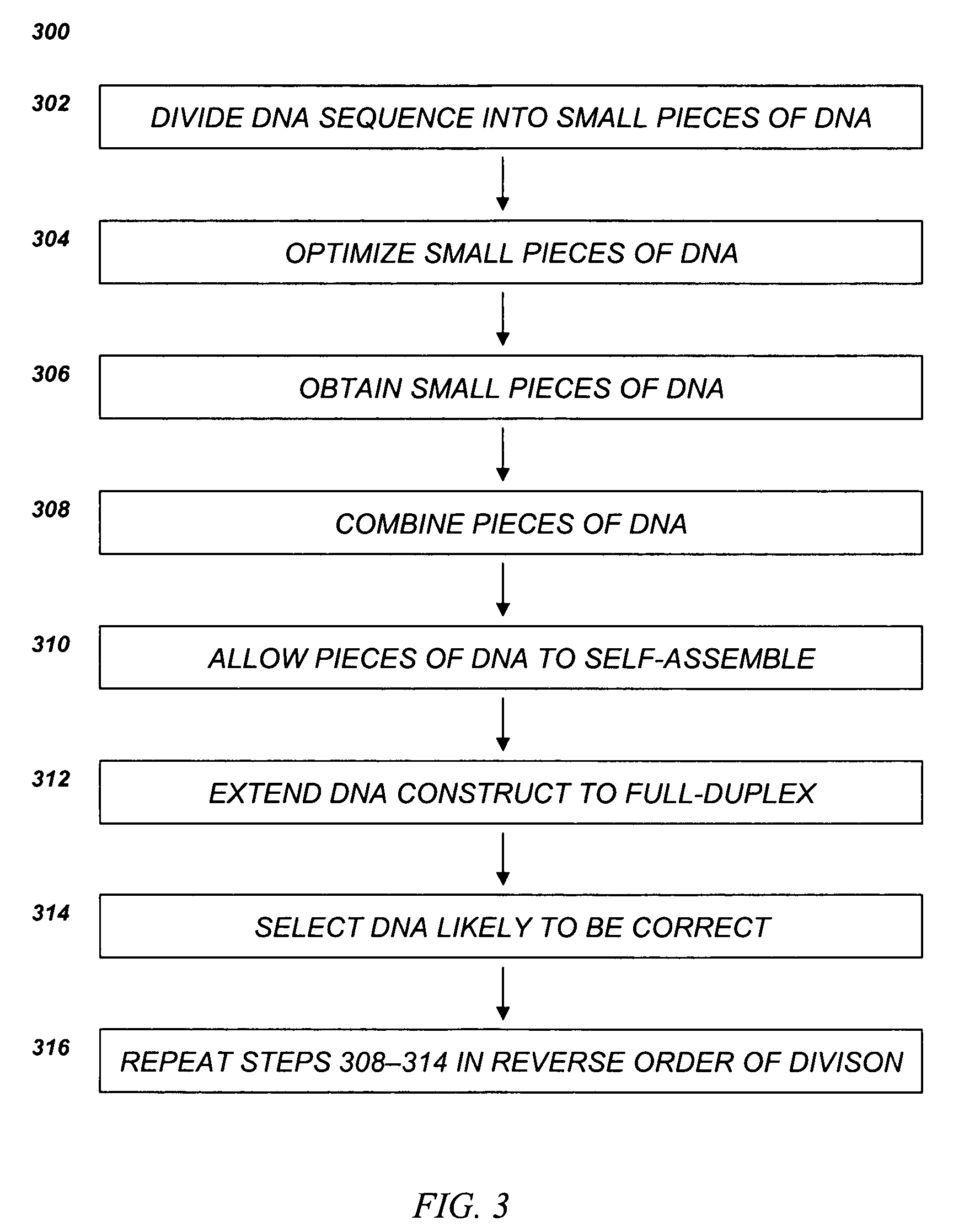Method for producing a synthetic gene or other DNA sequence
- Summary
- Abstract
- Description
- Claims
- Application Information
AI Technical Summary
Benefits of technology
Problems solved by technology
Method used
Image
Examples
example 1
E. coli Threonine Deaminase by Two-step Recursive Decomposition and Overlap Extension Assembly
[0150]EXAMPLE 1 illustrates the synthesis of an E. coli threonine deaminase gene by a two-step hierarchical decomposition and reassembly by overlap extension. E. coli threonine deaminase is a protein with 514 amino acid residues (1,542 coding bases).
Design
[0151]The sequence design method permuted synonymous (silent) codon assignments to each amino acid in the desired protein sequence. Each synonymous codon change results in a different artificial gene sequence that encodes the same protein. Because E. coli was the desired expression vector, the initial codon assignment was to pair each amino acid with its most frequent codon according to E. coli genomic codon usage statistics. Subsequently, the codon assignments were perturbed as described below. The final codon assignment implied a final DNA sequence to be achieved biochemically.
[0152]In this two-step hierarchical decomposition, the gene w...
example 2
variola DNA Polymerase by Three-step Recursive Decomposition and Overlap Extension Assembly
[0170]EXAMPLE 2 illustrates the synthesis of a variola DNA polymerase gene by a three-step hierarchical decomposition and reassembly by overlap extension. variola DNA polymerase is a protein with 1,005 amino acid residues (3,015 coding bases). variola DNA polymerase is also referred to as “Varpol” and “vpol” herein.
Design
[0171]Because the variola DNA polymerase gene was intended for expression in E. coli, codon selection considerations were similar to those used in the design of E. coli threonine deaminase described in EXAMPLE 1.
[0172]The three-step hierarchical decomposition was performed as follows. First, the gene was divided into two large pieces of about 1,500 bases. The first large piece is designated herein as “Part I” or “polymerase-1.” The second large piece is referred to herein as “Part II” or “polymerase-2. ” Parts I and II were designed with complementary ApaI sites to allow their...
example 3
E. coli Threonine Deaminase by One-step Hierarchical Decomposition and Ligation
[0195]EXAMPLE 3 illustrates the synthesis of an E. coli threonine deaminase gene by dividing the gene in a one-step hierarchical decomposition and synthesizing the gene by the direct self-assembly method.
Design
[0196]In the one-step hierarchical decomposition, the gene was divided directly into 54-overlapping short segments, in the present example not longer than about 60 bases, overlap not shorter than about 27 bases. Because the gene was designed for reassembly by ligation, the adjacent short segments on the same strand abut, i.e., with no single-stranded gaps between the double-stranded overlaps. The overlaps were not designed to terminate in a G or C.
[0197]Theoretical melting temperatures were calculated as described in EXAMPLE 1. The distribution of calculated melting temperatures of the short segments using the most common E. coli codons is provided in FIG. 32. The codons were permuted to increase th...
PUM
| Property | Measurement | Unit |
|---|---|---|
| Melting point | aaaaa | aaaaa |
| Melting point | aaaaa | aaaaa |
| Melting point | aaaaa | aaaaa |
Abstract
Description
Claims
Application Information
 Login to View More
Login to View More - R&D
- Intellectual Property
- Life Sciences
- Materials
- Tech Scout
- Unparalleled Data Quality
- Higher Quality Content
- 60% Fewer Hallucinations
Browse by: Latest US Patents, China's latest patents, Technical Efficacy Thesaurus, Application Domain, Technology Topic, Popular Technical Reports.
© 2025 PatSnap. All rights reserved.Legal|Privacy policy|Modern Slavery Act Transparency Statement|Sitemap|About US| Contact US: help@patsnap.com



